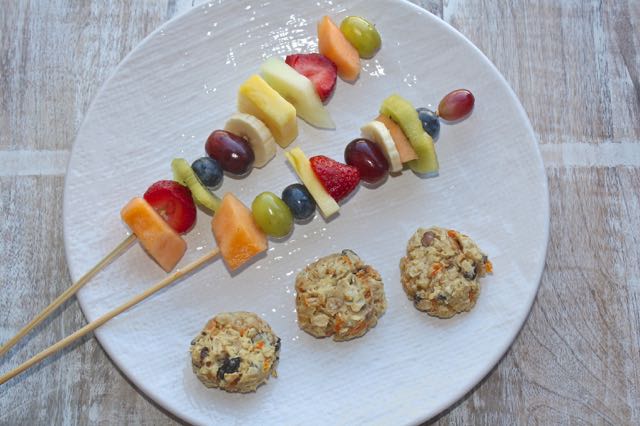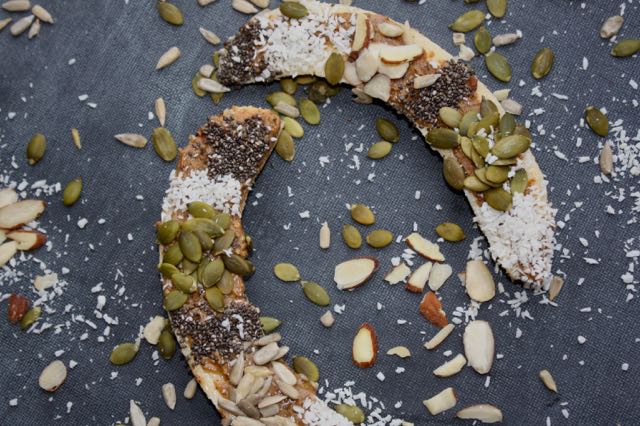The low FODMAP diet is best implemented with the guidance of a FODMAP knowledgeable dietitian as the diet is filled with many nuances, making it a bit confusing for the low FODMAP diet newbie.
Today, let’s review my top 5 potential low FODMAP diet pitfalls:
#1 Thinking all gluten free foods are low FODMAP
Many gluten free products include FODMAP containing ingredients such as: agave syrup, honey, apple and/or pear concentrate, chicory root extract (inulin), fructans, whole soybeans (edamame, crushed soybeans or soybean flour) or other bean flours making them likely HIGH FODMAP diet choices. Read ingredient labels carefully to check for hidden FODMAP ingredients.
#2 Consuming inadequate fiber
The reality is that many of us rely on whole grain wheat for fiber in our diet and this fiber source goes straight out the window with the start of the low FODMAP elimination diet. Don’t worry, the low FODMAP diet has many sources of healthy fiber rich foods. Work with your health care provider to individualize your fiber needs based on your medical history and symptoms. I find most of my clients can tolerate 20-25 grams of fiber per day. Some examples of low FODMAP fiber rich foods include: chia seeds, oat bran, oatmeal, rice bran, quinoa, pumpkin seeds, peanut butter, white potato with skin, blueberries, strawberries, an orange, 1/4 cup canned chickpeas (drained and rinsed) or 1/2 cup canned lentils (drained an rinsed), to name a few.
We love our Quinoa Kale Low FODMAP Vegan Nourish Bowl that provides a generous fiber boost to the diet.
#4 Avoiding dairy foods altogether resulting in inadequate calcium intake
With careful planning, consuming adequate calcium in your low FODMAP diet is easy. Include lactose free cow’s milk, hard cheeses, lactose free yogurt (such as Green Valley brand), chia seeds and kale to boost your calcium intake. Some individuals with food sensitivities can not tolerate any dairy foods in their diet, but I find this is a small subset of individuals. Inadequate calcium intake could compromise cardiovascular, bone and dental health. If you are reducing dairy or eliminating dairy in your diet, work with your dietitian to ensure adequate intake of calcium.
We add cheese to many of our recipes on the Well Balanced FODMAPer to boost calcium intake! This Quinoa Crusted Chicken Parmesan is fiber rich too!
#5 Consuming more than one fruit serving at a time
Fructose, in excess of glucose, in a food is considered a FODMAP source though tolerance varies person to person. Fruits that are considered low FODMAP do not have excess fructose in them. Consuming too much fructose at a sitting, even if the fruit is considered low FODMAP fruit may contribute to symptoms as well. A large fructose load at one meal can be difficult for the body to absorb adequately. When fructose is not absorbed adequately from the GI tract, it pulls water into the small intestine and can contribute to GI symptoms. During the elimination phase of the low FODMAP diet, I encourage clients to limit to just one fruit serving per meal or snack time. The Monash University low FODMAP diet app is a great resource for FODMAP portion control. If you have a smart phone, I encourage you download this app to provide guidance. Many FODMAPers make the mistake of loading up on fruit when making a fruit smoothie! For tips on making a yummy low FODMAP smoothie, check out my post here and print out the smoothie handout!
Nothing says fruit portion control like a fruit kabob! We love the look of these kabobs too…so enticing! Fruit kabobs are a yummy accompaniment to our Carrot Cake Breakfast Cookies!
And one more for good measure: Relying on convenience food products with long ingredient lists
If you are like me, your busy lifestyle lends itself to reliance on foods on the fly! I love to have a couple low FODMAP snacks with me at all times. The problem with relying on manufactured products with LONG ingredient lists is that they often contain ingredients that have not been officially tested for FODMAP content–invert sugar (might vary in FODMAP content), maltodextrin (might vary in FODMAP content) etc., corn fiber, sugar fiber have an unknown FODMAP content. Selecting foods created by Mother Nature or those with ingredients that have been tested (i.e. peanut butter) might be your best bet. Snacking on banana with a little natural peanut butter, an orange with a handful (10) almonds, popcorn, a cheese stick or two and a handful of grapes are tasty, low FODMAP and nutritious. For now, I do allow foods that contain invert sugar and maltodextrin and my clients have done beautifully with them. It is just hard to know FODMAP content of some untested ingredients as they may vary manufacturer to manufacturer. It’s easy to get hung up over ingredients… but I also recommend you listen to your body and enjoy what works for you.
These decorated bananas (with no hidden ingredients!) are so visually appealing and taste great too! We add a thin layer of peanut or almond butter and top with a variety of wholesome seed and nut toppings.
Today I will be working more on chocolate peanut butter lava cake recipes…I hope to have the recipe posted later this week!





Sandy Gold Raynes
Great information! Along with not assuming that all gf foods are ok, is not assuming that all lactose-free dairy products are ok. Some of them contain inulin, chicory root, or other difficult foods.
katescarlata
Great point, Sandy. Yes, some yogurts and kefir have added chicory root or inulin! Thanks for sharing this important point!
catrin jonsson
If you can get the LACTEEZE pills where you live (they contain the lactase enzyme) try them, they work magic for me, 2pills for a regular caffe latte and I am set.
Another thing I have notice here in Australia is many bread manufacturers are now using soy flour, and that does not work for me at all. Took me a while to work that one out too. 🙂
katescarlata
Thanks for sharing, yes the lactase enzyme tablets can help your body digest lactose containing foods–thanks for sharing Catrin!
Elizabeth
I made this with peanut butter and a few other modifications (whole coconut milk, light olive oil). The amount of cocoa might be too much for some but was ok for me. http://www.taste.com.au/recipes/39199/5+minute+gluten+free+molten+chocolate+mug+cake
Linda
As a vegan on low fodmap, I have adjusted my diet and have had no problem getting my calcium, I use a tablespoon of tahini in my salads, and I also use chia and almond milk. Leafy greens also have calcium. Making your own almond milk is a must so you can control the indgredients and also you can water it down more so you don’t have too much fodmaps from almonds.
I also found that different fruits even low fodmap effect me, I cannot eat very ripe kiwi or bananas, they have to be just ripe. Although I dont have a problem with papaya ripe or not. So you have to experiment with fruit with amounts and ripeness.
Linda M.
I have been trying to get more protein & calcium in my diet. The Low Fodmap diet is not well known in Southern Oregon where I live. The only dietitian I could find was for diabetics; she had heard of the diet, but hadn’t really study it. My gastro doctor does not know much about the diet, but he did find one doctor who does; she is going to treat me for Sibo when she gets back from India. The diet has made a big difference, however, there is still something not right that I am doing. I am still loosing weight (43 pounds) and now my hair is falling out. I really appreciate all the information that your provide to us Kate, as there is not many resources here.
katescarlata
Hi Linda, It might not be something that you are doing–but rather you have an underlying medical condition such as SIBO that is making it difficult for your body to get the nutrition it needs. It’s easy to blame ourselves when we don’t feel well–‘it must be something I ate’ is a common thought—the reality is—you are doing the best you can. And sometimes our body doesn’t cooperate. I hope that your physician is doing adequate testing–to make sure that there is not another underlying issue such as a thyroid issue that is contributing to your symptom profile. Take care!!
Linda
Kate,
I have been on thyroid medication for several years; the hydrogen breath test was inconclusive. Just a quick question for you, as I do not want to take advantage of your time. My husband had bought me a gluten free cupcake for Mother’s Day and I am wondering if the sugar content was too high? Normally, the only Kane sugar I have is in my decaf coffee. I had oatmeal with peanut butter and two raspberries before work this morning, and an hour later I was in the bathroom with bad pains and other yucky stuff.
Thank you Kate!
katescarlata
I can’t really comment Linda without knowing your full history, but yes, too much sugar can be a problem–especially in the setting of bacterial overgrowth of the small intestine. Also from FODMAP perspective, the oatmeal limit is just 1/2 cup cooked–it’s easy to consume more–so be careful with that.
Linda M.
I understand, thank you so much for the information!
Stephanie
Hi Kate – and first, THANK YOU for this blog! My question: I know cashews are high FODMAPs, but I read somewhere (and cannot remember where) that cashew milk – as in dairy-free (and soy free, gluten free) ice cream – was OK. Is that really true? Any info and/or resources would be great – I really miss good ice cream!
With much appreciation….
Susan M
Hi Kate,
I am on a low fodmap diet and follow it carefully. I know that cashews are a high fodmap food but an wondering if non dairy icecream made with cashew milk might be ok. Also I would greatly appreciate knowing which sour dough breads might be acceptable.
Thank you,
Susan M
katescarlata
I would think cashew ice cream would be high fodmap–but not sure that it has been tested! As for sourdough bread, I would call different local bakeries or manufacturers to learn how their sourdough bread is made–it should be slow leavened- using active sourdough cultures and NO yeast. I find many of my clients can tolerate Iggy’s breads–the country loaf and Francese loaf –which are slow leavened–these are available at Whole Foods–though not sure which stores–might be regional –so call first. Some of my clients have also tried Nashoba bakery sourdough w/ good tolerance too. Its individual–so perhaps trial small amounts to test your tolerance.
Lindsay
Hi Kate,
I’m doing the low FODMAP elimination diet with a dietitian, but am having occasional symptoms that I think are tied to corn. What do you know about corn products (e.g. corn tortillas, corn chips)? They are supposed to be low FODMAP, but my stomach is sometimes upset when I eat them (even checking ingredients lists for everything else). Is there something else going on?
Thanks!
katescarlata
Have you had corn ruled out as an allergy? I have had a few patients with corn allergies. Might be that there are other ingredients in the corn products–many add wheat these days. I also have learned that my patients sometimes overeat the corn chips–and the fat content of the corn chips in large quantity are the culprit.
Lindsay
I haven’t. I’m going to take it out entirely and see what happens. Thanks for your suggestions!
Linda dc
I agree processed corn is a problem for me, I had to give up corn chips, it is just stale dried corn dipped in oil. Also I found fresh corn has to be very fresh, juicy almost, and not too much at once, maybe only half an ear. You can make ‘corn chips’ out of flat bread, cut up and dry in the oven. Use fodmap friendly flat bread of course (easy to make from scratch too).